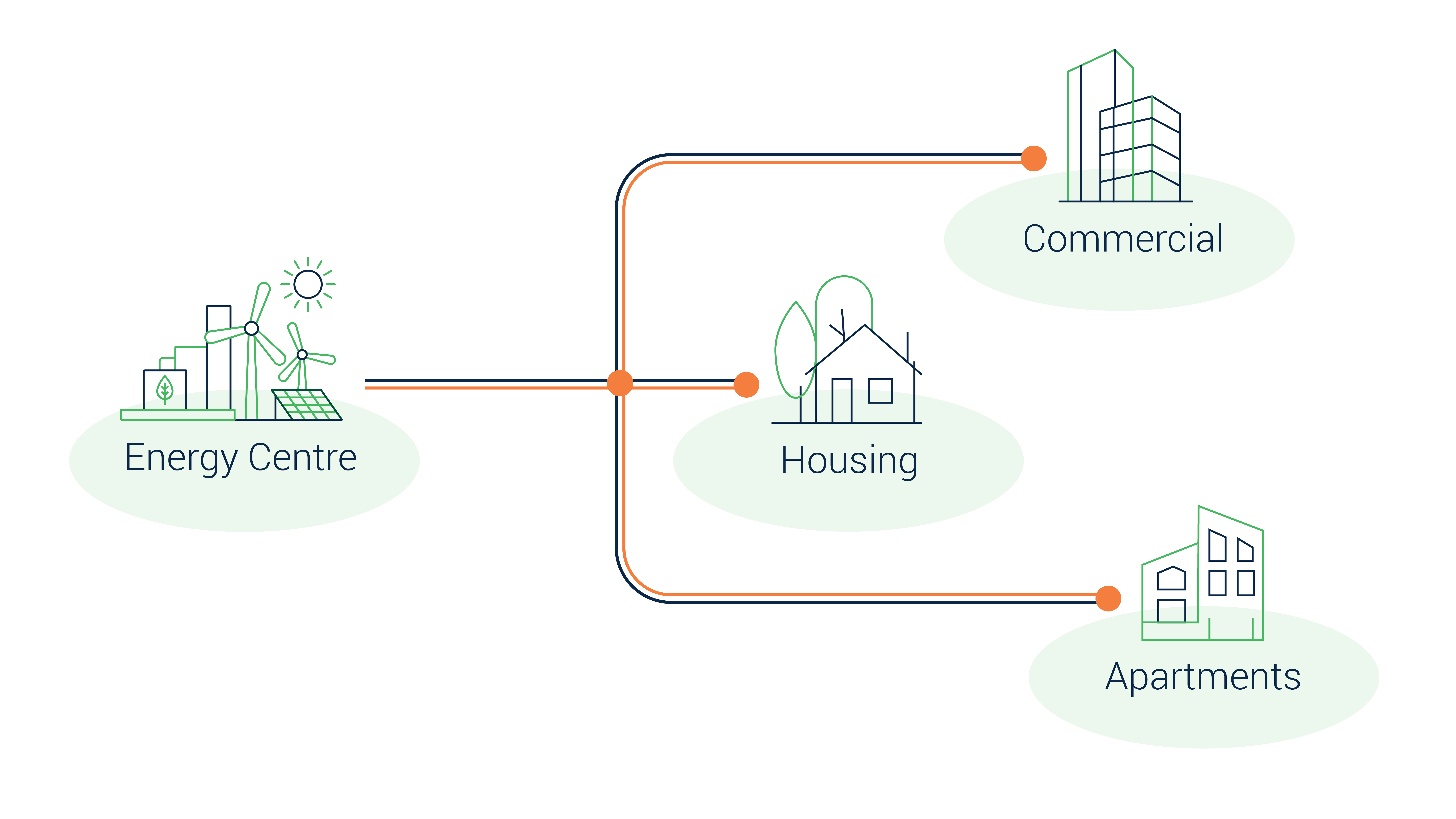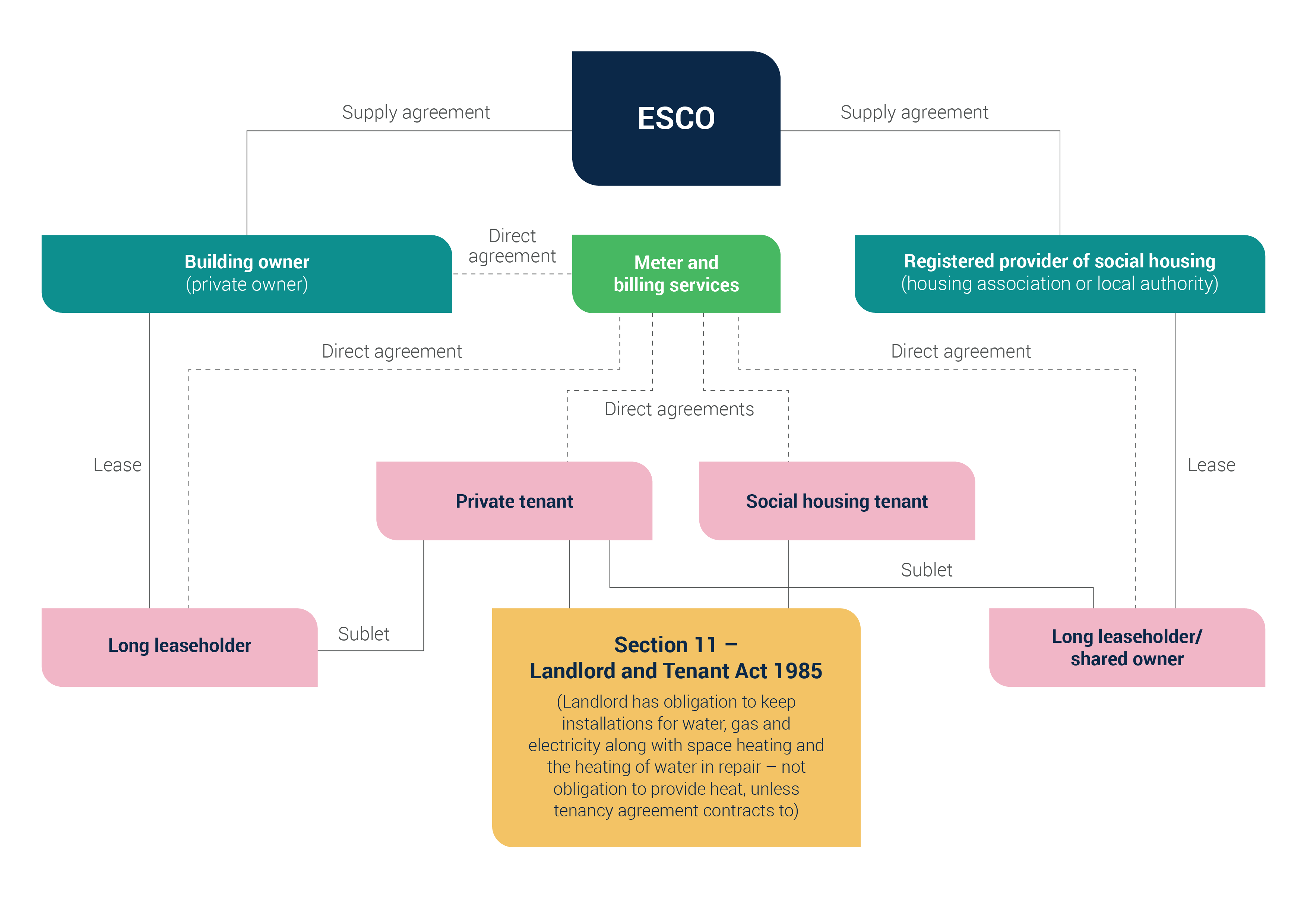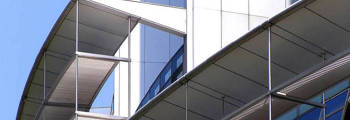13/10/2025
Part of our Points of Connection series
Written by Harriet Murray Jones, Sarah Orchard and Ffion Benham
This article summarises some of the key issues raised in our recent Points of Connection webinar – Property is it more than just pipes. Points of Connection is our series of webinars, articles and newsletters to support anyone operating in, or coming into, the district energy sector to learn more about heat networks. You can view our full Points of Connection webinar series or visit our Points of Connection hub.
Are District Heat Networks really more than just pipes? In short, the answer is yes. It is in our experience a risk that the commercial deal gets focused on but in reality the interplay of property rights and landlord and tenant obligations cannot be understated.

Property Rights
Property rights will be needed for the Energy centre or centres, the pipes themselves and at the point of connection which may be residential, or commercial.
Initial Questions
When reviewing the property aspects of a District Heat Network, the first thing we need to do is consider how to approach the property rights in relation to the Energy Centre, and ask ourselves the following questions:
- Is it going to be a leasehold or freehold interest?
- Is it a standalone building or is it integrated into an existing building?
- Is it already built, or will it need to be built?
- Who has the development obligations?
In many cases the property interest will be a lease of whole or part, and in such cases, we need to think about how long the lease will be in place for, together with what rights we will need to access it and use it for the purpose its intended.
We must also consider if the leasehold interest will be shared or whether it will be exclusively occupied occupation. Who else, if anyone will need to use it or have rights. In the fewer cases where it is a freehold, the process is often more simple as it’s a transfer of land.
The ownership structure needs to be considered early.
Responsibility
A District Heat Network will have a Primary Network and a Secondary Network of pipes. The next step is to consider the two separate parts of the network, and ask further questions such as who is responsible for installing both parts of the network, and indeed whether any of it is already in place and what rights(if any exist) or nee extending.
At some point responsibility for the network of pipes will eventually change hands, from the energy company to the end user. This often takes place at the plate heat exchanger (but not always!). Therefore, the overarching structure of the process needs to be thought of right from the outset, as early clarification on the following is essential:
- What forms the Primary Network?
- What forms the Secondary Network?
- What is already in place?
- Where is the change in responsibility for the network taking place?
Practical considerations
To facilitate all the work needed for the creation of a District Heat Network, there are practicalities that need consideration. There will be many large pipes that need storing, so we need to think about where these will be stored, how long they need storing, and if the storage facility is sufficient.
All these factors, which may seem small in the grand scheme of things, are of significant importance and require consideration as early as possible.
Landlord and Tenant Issues
It is important to consider who is likely to be the end occupier of any residential property, as different rules will apply in respect of the landlord’s repairing obligations and ultimately whether those costs can be recoverable from the occupier.
We have included a diagram below which touches on the intricacies of landlord and tenant issues on a heat network.

Repairing obligations
Very often on mixed use estates, landlords will have different types of occupiers such as rented, leased or shared ownership, or a combination of them all.
If the property is occupied by secure, assured or assured shorthold tenants, then s11 of the Landlord and Tenant Act 1985 (LTA 1985) will apply. The majority of tenancy agreements will include a specific section confirming what the landlord’s repairing obligations are, but if not, then s11 implies a term into the tenancy agreement that the landlord will:
Keep in repair and proper working order the installations in the dwelling, or installations which directly, or indirectly, serve the dwelling and which form part of a building which the landlord has an estate or interest, or which is under its control, for
- The supply of water, gas and electricity; and
- Space heating and heating water
If, when complying with the above, the landlord incurs a cost, these costs cannot be passed back to the tenant, whether that be in a standing charge or otherwise. However, anything which is not a repairing or maintenance obligation, including energy usage, can potentially be passed to the tenant – usually by way of a variable service charge or a separate heat supply agreement.
If the property is occupied by leaseholders (including shared owners), then the repairing and maintenance obligations will be within the lease itself, each being unique, and this must be checked thoroughly to ensure compliance and the ability to recharge. Usually, any costs associated can be passed back to the leaseholder, again by way of a variable service charge.
Consultation
Another important section of the LTA 1985 is s20, which deals with the requirement to consult with any resident where the landlord intends to carry out certain works, or enter a long-term agreement, and ultimately intends to pass these costs back to those occupying. Consultation is required if any of the following apply:
- If building works are required – if the costs of these works, after being divided with the number of residents, exceeds £250 per leaseholder/tenant;
- If the landlord intends to enter into a long-term agreement for more than 12 months which results in each leaseholder/tenant being charged more than £100 each;
- If the landlord intends to carry out works under a long-term agreement and the works will exceed £250 per leaseholder/tenant.
The requirements relating to the method and stage of the consultation are set out in s20 of the LTA 1985, but in summary includes the landlord needing to; write to the residents explaining what is due to take place and keeping them involved in the process throughout. If there is non-compliance with these requirements, the recoverability of any costs is limited to £250 per leaseholder/tenant for any qualifying works and £100 per year for qualifying long-term agreements.
If the landlord needs to proceed with work urgently (and therefore cannot wait to proceed through consultation), or where valid consultation has not been carried out, a landlord can consider applying for dispensation (from the requirement to consult) from the First-Tier Tribunal. However, there is certainly no guarantee that this will be given and therefore we strongly suggest prompt legal advice is obtained.
Accordingly, property rights, liability and landlord and tenant issue considerations cannot be rushed and should be carefully reviewed from the outset of a District Heat Network process. A precise plan and process should be agreed and followed throughout to ensure compliance, and to avoid any unnecessary delays. We did say it was more than just pipes!
If you would like to discuss any of the issues raised in this article please contact Harriet Murray Jones or Sarah Orchard who would be happy to discuss.
Stay switched on – follow our dedicated Bevan Brittan | Energy & Resource Management LinkedIn page.




